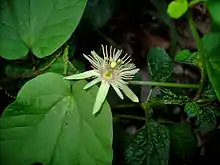Passiflora rubra
Passiflora rubra, the Dutchman's laudanum,[1] is a species in the family Passifloraceae. It is native throughout the West Indies, and to Colombia, Venezuela, Peru, Ecuador, Bolivia and eastern Brazil.
| Passiflora rubra | |
|---|---|
 | |
| Scientific classification | |
| Kingdom: | Plantae |
| Clade: | Tracheophytes |
| Clade: | Angiosperms |
| Clade: | Eudicots |
| Clade: | Rosids |
| Order: | Malpighiales |
| Family: | Passifloraceae |
| Genus: | Passiflora |
| Species: | P. rubra |
| Binomial name | |
| Passiflora rubra | |
Passiflora rubra is vegetatively almost indistinguishable from Passiflora capsularis, but the two species may be distinguished in flower and fruit. The ovaries of the flowers of Passiflora rubra has a dense coating of white, or less commonly brownish hairs, and the fruit, while variable in shape, is always obovoid, unlike that of Passiflora capsularis which is tapering at both ends.
References
- "Passiflora rubra". Natural Resources Conservation Service PLANTS Database. USDA. Retrieved 15 September 2015.
This article is issued from Wikipedia. The text is licensed under Creative Commons - Attribution - Sharealike. Additional terms may apply for the media files.